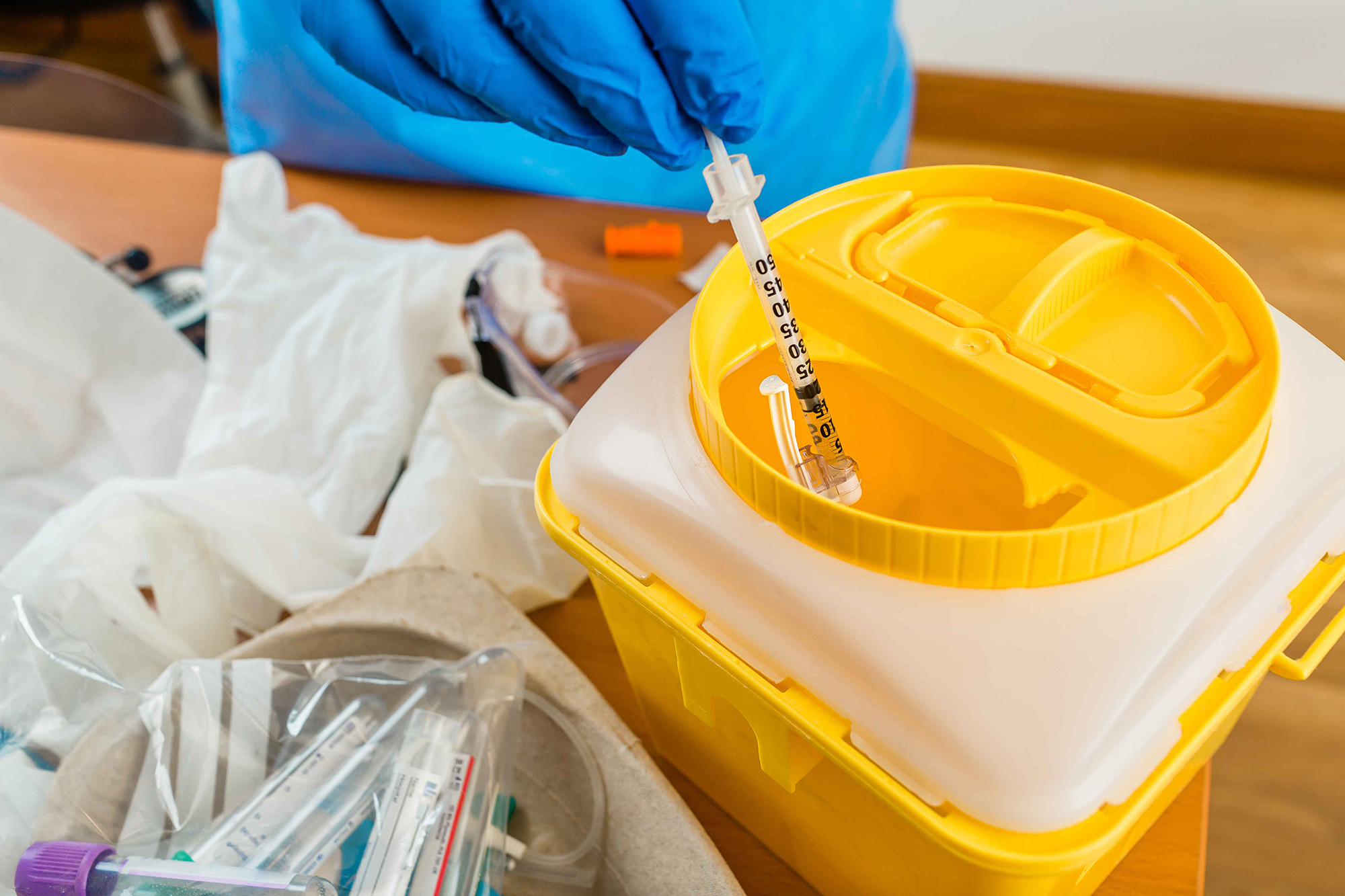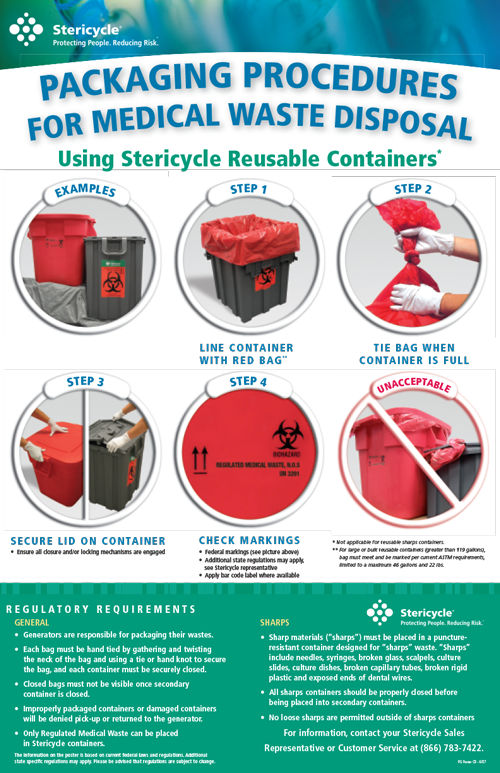Compliance and Laws for Medical Waste Disposal
Conformity and policies for clinical waste disposal play a vital role in making certain the safety and well-being of both healthcare professionals and the general public. Appropriate monitoring of clinical waste is essential to prevent the spread of infections, safeguard the atmosphere, and preserve public health and wellness. These guidelines incorporate different facets, consisting of the classification and partition of clinical waste, correct storage and dealing with procedures, as well as transport and disposal approaches.
Significance of Compliance
The importance of compliance with guidelines for clinical waste disposal can not be overstated. Correct disposal of clinical waste is crucial for guaranteeing the security and well-being of healthcare employees, people, and the basic public. Clinical waste, which consists of products such as used needles, contaminated handwear covers, and biomedical waste, can present severe health and wellness dangers if not handled and gotten rid of correctly.
Compliance with laws makes certain that clinical waste is managed in a manner that decreases the possibility for direct exposure to infectious diseases and unsafe compounds - medical waste disposal. It helps protect against the spread of infections, such as HIV, hepatitis B and C, and other bloodborne microorganisms. Compliance additionally plays a crucial role in protecting the setting by avoiding contamination of water resources, soil, and air
Failing to adhere to regulations can lead to extreme repercussions for medical care facilities, including fines, lawful action, and damage to their reputation. In addition, non-compliance may jeopardize the health and security of healthcare employees, patients, and the neighborhood.
Conformity with policies for clinical garbage disposal requires adherence to certain standards and protocols. These might consist of proper segregation, product packaging, labeling, and storage space of medical waste. It likewise includes making use of approved disposal techniques, such as incineration, autoclaving, or landfilling, depending upon the kind of waste.
Governing Agencies and Bodies
Regulatory agencies and bodies play a crucial role in supervising compliance with guidelines for clinical garbage disposal. These organizations are accountable for setting criteria, methods, and standards to make certain the secure and appropriate handling of medical waste. They keep track of and impose compliance to protect public health and the environment.
One of one of the most famous regulatory companies in the USA is the Environmental Security Firm (EPA) The EPA is in charge of managing the storage space, transport, treatment, and disposal of clinical waste. They develop guidelines for waste generators, carriers, and treatment facilities to adhere to, making sure that all necessary safety measures are required to avoid the spread of diseases and contamination.
An additional crucial regulative body is the Occupational Safety And Security and Health And Wellness Management (OSHA) OSHA sets guidelines and requirements to protect employees from work-related hazards, consisting of those associated to medical waste. WasteX Medical Waste Disposal. They give guidelines for the secure handling and disposal of medical waste to shield workers in healthcare centers
Along with these government agencies, private states also have their own governing bodies that supervise clinical waste disposal. These companies might have their own certain regulations and demands that have to be followed.

Classification and Partition of Clinical Waste
To make sure correct management of medical waste, it is vital to categorize and segregate it according to developed guidelines and procedures. medical waste disposal. Category and partition play an important duty in minimizing the risk of infection, securing the setting, and guaranteeing the security of health care employees and the public
Clinical waste is categorized right into various classifications based upon its possible hazard level. These categories include transmittable waste, pathological waste, sharps waste, pharmaceutical waste, chemical waste, and contaminated waste. Each category requires particular handling, storage, disposal, and transportation methods to minimize the risk of exposure and contamination.
Partition of clinical waste entails dividing various sorts of waste at the resource. This procedure makes certain that waste with various danger degrees is not blended, minimizing the possibility for cross-contamination and making disposal treatments a lot more effective. Appropriate segregation is achieved through using color-coded tags and containers, which assist medical care workers and waste management personnel deal with each type and identify of waste appropriately.
Along with category and segregation, medical care centers should also stick to regional, state, and federal regulations concerning medical waste monitoring. These policies outline details demands for storage, transport, treatment, and last disposal of clinical waste, guaranteeing conformity and keeping public health and safety.
Appropriate Storage and Handling Treatments
Correct storage space and handling treatments play an essential role in making sure the risk-free and compliant management of medical waste. Clinical waste, that includes products such as utilized syringes, contaminated handwear covers, and ran out medications, can present significant wellness and environmental dangers otherwise dealt with correctly. It is vital for healthcare centers and other generators of medical waste to apply stringent storage space and dealing with methods.
To begin with, clinical waste ought to be saved in resilient, watertight containers that are specifically created for this objective. These containers ought to be identified with the global biohazard symbol and words "clinical waste" to clearly suggest the materials. Additionally, the containers must be maintained securely near stop any prospective leak or splilling.
Furthermore, it is essential to set apart different kinds of medical waste to stop cross-contamination. Sharps, such as needles and scalpels, ought to be kept in puncture-resistant containers to decrease the risk of injuries - WasteX Medical Waste Disposal. Chemical waste, such as disinfectants and solvents, should be saved separately from various other kinds of medical waste to stop chain reactions or dangerous exposures

Transportation and Disposal Methods
Medical care centers should guarantee the secure transport and proper disposal of their medical waste to abide by guidelines and safeguard public health. Transport and disposal methods play an essential duty in stopping the spread of contagious diseases and decreasing the environmental influence of medical waste.
To transport clinical waste, healthcare centers ought to make use of puncture-resistant and watertight containers that are identified with the biohazard icon. These containers must be securely sealed to stop any kind of leakage throughout transportation. In addition, healthcare centers should establish methods for the transportation procedure, including making use of qualified workers and dedicated automobiles.
Once the medical waste gets to the disposal facility, it undergoes different methods of treatment - WasteX Medical Waste Disposal. One typical method is incineration, which entails melting the waste at high temperature levels to destroy virus and lower the volume of waste.
It is essential for health care centers to collaborate with licensed and permitted waste administration business to make sure correct transport and disposal of clinical waste. These business have the competence and sources to take care of medical waste safely and in conformity with policies.
Conclusion
In conclusion, conformity with policies for clinical waste disposal is of utmost significance to make certain public health and wellness and safety. On the whole, adherence to compliance and regulations is needed to effectively handle clinical waste.
Medical waste, which consists of items such find here as utilized needles, contaminated gloves, and biomedical waste, can posture major wellness dangers if not dealt with and disposed of appropriately.
These groups include contagious waste, pathological waste, sharps waste, pharmaceutical waste, chemical waste, and contaminated waste.Segregation of medical waste includes dividing different types of waste at the resource. Correct segregation is accomplished via the use of color-coded containers and labels, which help health care employees and waste management workers recognize and handle each type of waste correctly.
Chemical waste, such as solvents and disinfectants, must be saved separately from other kinds of clinical waste to prevent unsafe direct exposures or chemical responses.